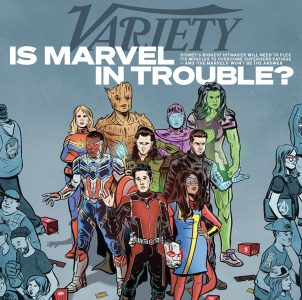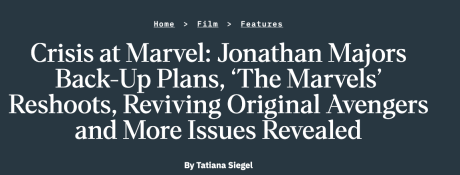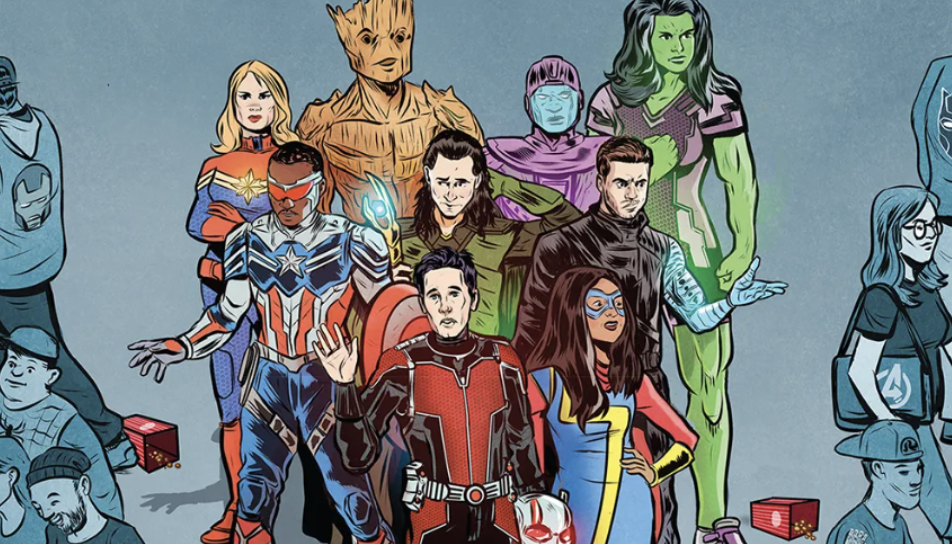“The Marvel machine was pumping out a lot of content, but did it get to the point where there was just too much, and they were burning people out on superheroes?”
This quote, spoken by Wall Street analyst Eric Handler and reported by Variety‘s Tatiana Siegel, is music to Hollywood Elsewhere’s ears.
I’ve been waiting for over a decade for the Marvel downfall or at least the gradual weakening of this satanic strain, and now that it’s slowly, finally happening there are tears of joy in my eyes.
I haven’t felt this good since the death of Robert Downey, Jr.’s Tony Stark, and I was clicking my heels over that one.
The impetus behind Siegel’s new “Marvel is in trouble” article (okay, call it a “the tide has turned and things are swirling downward” piece) boils down to widespread readings and presumptions about The Marvels (Disney, 11.10) blowing the big one.
That plus the seeming downfall of Jonathan Majors, but this has been a nagging legal thing for several months now, partly due to Siegel reporting on Major’s issues (sexual assault charges) and seemingly pushing for his demise.

Even I, a committed hater of all things spandex and particularly a cinematic brand that significantly contributed to the death (or at least the diminishing popularity until Oppenheimer came along) of tangy, character-driven, real-world theatrical films…Marvel plus Covid plus streaming plus the appalling cinematic tastes of Millennials and Zoomers…a brand that every major over-45 filmmaker (Marty!…Fuck Joe Russo!) has been deploring and damning for years…even I was delighted by Spider-Man: No Way Home two years ago…I admit it.
But generally the Marvel machine was been drooping and groaning and shortfalling for at least a couple of years now, and not just in my head.
Siegel: “The source of Marvel’s current troubles can be traced back to 2020. That’s when the COVID pandemic ushered in a mandate to help boost Disney’s stock price with an endless torrent of interconnected Marvel content for the studio’s fledgling streaming platform, Disney+.
“According to the plan, there would never be a lapse in superhero fare, with either a film in theaters or a new television series streaming at any given moment.
“But the ensuing tsunami of spandex proved to be too much of a good thing, and the demands of churning out so much programming taxed the Marvel apparatus. Moreover, the need to tease out an interwoven storyline over so many disparate shows, movies and platforms created a muddled narrative that baffled viewers.
“‘The more you do, the tougher it is to maintain quality,” says Handler. “[Marvel] tried experimenting with breaking in some new characters, like Shang-Chi and Eternals, with mixed results. With budgets as big as these, you need home runs.”
Speaking of Eternals, another anvil tied around Marvel’s ankles these days are workester themes and plotlines. Fanboys don’t like that shit as a rule. Just ask Kathy Kennedy.
Siegel: “The Marvels will struggle to get the ball past the infield, at least by Marvel’s outsized standards. The movie, which cost $250 million and sees Brie Larson reprising her role as Captain Marvel, is tracking to open to $75 million-$80 million — far below the $185 million Doctor Strange in the Multiverse of Madness took in domestically in its debut weekend last year.
“The Marvels has seen its release date moved back twice, too, once to swap places with Quantumania, which was deemed further along, and again when its debut shifted from July to November to give the filmmakers more time to tinker. But that extra time didn’t necessarily help. In June, Marvel, which traditionally only solicits feedback from Disney employees and their friends and families, took the uncharacteristic step of holding a public test screening in Texas. The audience gave the film middling reviews.”


